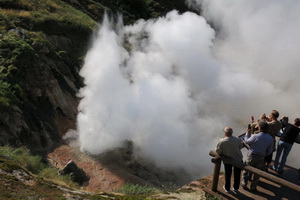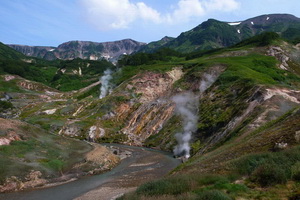Main / Sights
UZON CALDERA (Caldera of the Uzon Volcano)
It is a pit-like crater of 9x12 km size; it is one of the biggest calderas in Kamchatka. The top point of the caldera edge is the Baraniy peak (1617 m over the sea level); the bottom is at 650-700 m over the sea level. The caldera was formed about 40 thousand years ago. In the east part of the caldera there is one of the greatest explosion craters in Kamchatka - it has the diameter of 1,65 km and is filled with the waters of the Dalnee Lake (Far Lake). The west part of the caldera is swamped. There are several lakes in that part, the biggest one is the Central Lake, which gathers the water from all caldera. In the west and the north the caldera is surrounded by the ridge - the remnants of an ancient volcano.
The hydrothermal system of the Uzon is one of the most powerful in Kamchatka. The narrow 200-350 m zone is sectioned into 5 thermal fields and includes thousands of thermal springs of different size and form, numerous vapour streams, mud volcanoes and pools, thermal lakes.
There, like nowhere in the world, different developments of recent volcanism,
glacier products, solfatara fields with native sulphur deposits and hydrothermal
masses of multicoloured altered rocks are observed.
In the underground waters, which come up on the surface, many ore minerals are
discovered (arsenic, mercury, zinc, etc.). While the water mixture cools, these
minerals deposit around the springs. In some sense, one can observe the ore
formation. The hydrothermal springs are also interesting. Rocks also change
under the influence of them. It is very important to explore this process, it is
one of the volcanologists aims.
Now the arsenic-antimony-mercury-sulphide ores deposit is being formed, and the
unique oil deposit is observed near.
The unique mineralogical palette of the Uzon caldera is proved by the following: there are 65 hydrothermal minerals discovered. In middle 80s two original forms of arsenic sulphide were first described: uzonite and alacranite. Uzonite is not discovered anywhere else on the planet outside the Uzon caldera.
After the long rest, in 2008 a geyser started fountaining again, which, of course, attracts more tourists and scientists.
Tours
 One-day excursion to the Valley of Geysers and Uzon caldera
The famous Valley of Geysers is a canyon which has one of the biggest geyser area in the world. It is hidden in a hard a...
One-day excursion to the Valley of Geysers and Uzon caldera
The famous Valley of Geysers is a canyon which has one of the biggest geyser area in the world. It is hidden in a hard a...
 Three-day excursion to the Valley of Geysers and Uzon Caldera
Unlike the standard one-day excursion, our ecological educational tour will let you not only to see these unique places ...
Three-day excursion to the Valley of Geysers and Uzon Caldera
Unlike the standard one-day excursion, our ecological educational tour will let you not only to see these unique places ...
